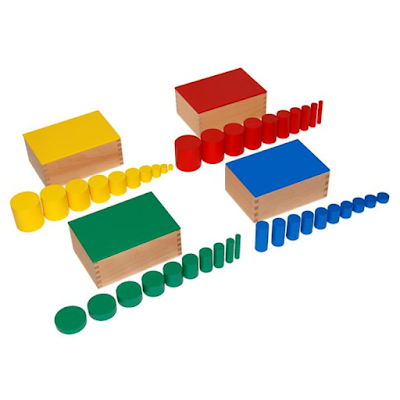Montessori education is known for its hands-on, child-centered approach to learning. Two essential materials in the Montessori curriculum that play a significant role in a child's mathematical development are the Geometric Cabinet and Knobless Cylinders. In this blog post, we'll explore these materials, their benefits, and how they lay the foundation for a solid mathematical understanding.
Montessori Geometric Cabinet: A Treasure Trove of Shapes
The Montessori Geometric
Cabinet, available through Kid Advance, is a fascinating educational tool
that consists of six drawers, each housing a set of geometric insets and
frames. These materials include six circles, six rectangles, seven triangles,
six regular polygons, four curvilinear figures, and six quadrilaterals. The
cabinet offers a wealth of opportunities for children to explore the world of
shapes, sizes, and spatial relationships, making learning engaging and
interactive for young minds. Kid Advance serves as a valuable source for
parents and educators to access these enriching materials, ensuring that the
Montessori approach to geometry is readily available to children.
The dimensions of the Geometric
Cabinet itself are 19 x 9.75 x 9.75 inches, making it an accessible and
inviting resource for children aged 3.5 years and up. This hands-on exploration
of geometry not only sparks a child's interest but also paves the way for a
deeper understanding of mathematical concepts.
When children interact with the
Geometric Cabinet, they learn to distinguish and recognize various shapes,
developing their visual and tactile perception. This experience provides a
solid foundation for geometry and helps them grasp concepts like area,
perimeter, and even trigonometry later in their educational journey.
Knobless Cylinders: A Journey
into Dimension and Comparison
Another essential Montessori material for
developing mathematical concepts is the Knobless Cylinders. This set
consists of four boxes, each containing ten cylinders that vary in height
and/or diameter. What sets them apart is the absence of knobs, challenging
children to rely on their visual and tactile senses to complete the exercises.
Each set of Knobless Cylinders
comes in a separate wooden box, with the lid painted the same color as the
cylinders - red, green, yellow, and blue. This visual connection helps children
match the correct cylinder to its place and develop their color recognition
skills, all while delving into the world of dimension and comparison.
The dimensions of each wooden box
are 6.5 x 4.5 x 2.75 inches, making them ideal for children aged 4 years and
up. The Knobless Cylinders offer experiences in comparison, grading, and
seriation. These activities are indirect preparation for mathematical concepts
like addition, subtraction, and more advanced concepts involving measurement
and quantity.
Through the Knobless Cylinders,
children can develop their ability to compare sizes and dimensions, enhancing
their understanding of concepts like "bigger" and
"smaller." This skill, which seems simple, forms the basis for more
complex mathematical operations.
The Synergy of Geometric Cabinet
and Knobless Cylinders
The Geometric Cabinet and
Knobless Cylinders may seem like separate entities, one focusing on shapes and
the other on dimensions, but they work in synergy to prepare children for more
advanced mathematical concepts. When children recognize shapes using the
Geometric Cabinet, they are indirectly exposed to concepts like congruence and
similarity, which are crucial in geometry. These geometrical insights are
further developed when children use the Knobless Cylinders to compare and
differentiate dimensions.
In conclusion, the Montessori
Geometric Cabinet and Knobless Cylinders are invaluable tools in the journey of
mathematical exploration. They lay a strong foundation for understanding
geometry and dimension, making abstract mathematical concepts tangible and
engaging for children. These materials are not just teaching aids; they are the
building blocks of mathematical knowledge and curiosity. So, as you introduce
your child to these materials, you're not just offering them educational tools;
you're providing them with the keys to unlock the world of mathematics.








No comments:
Post a Comment